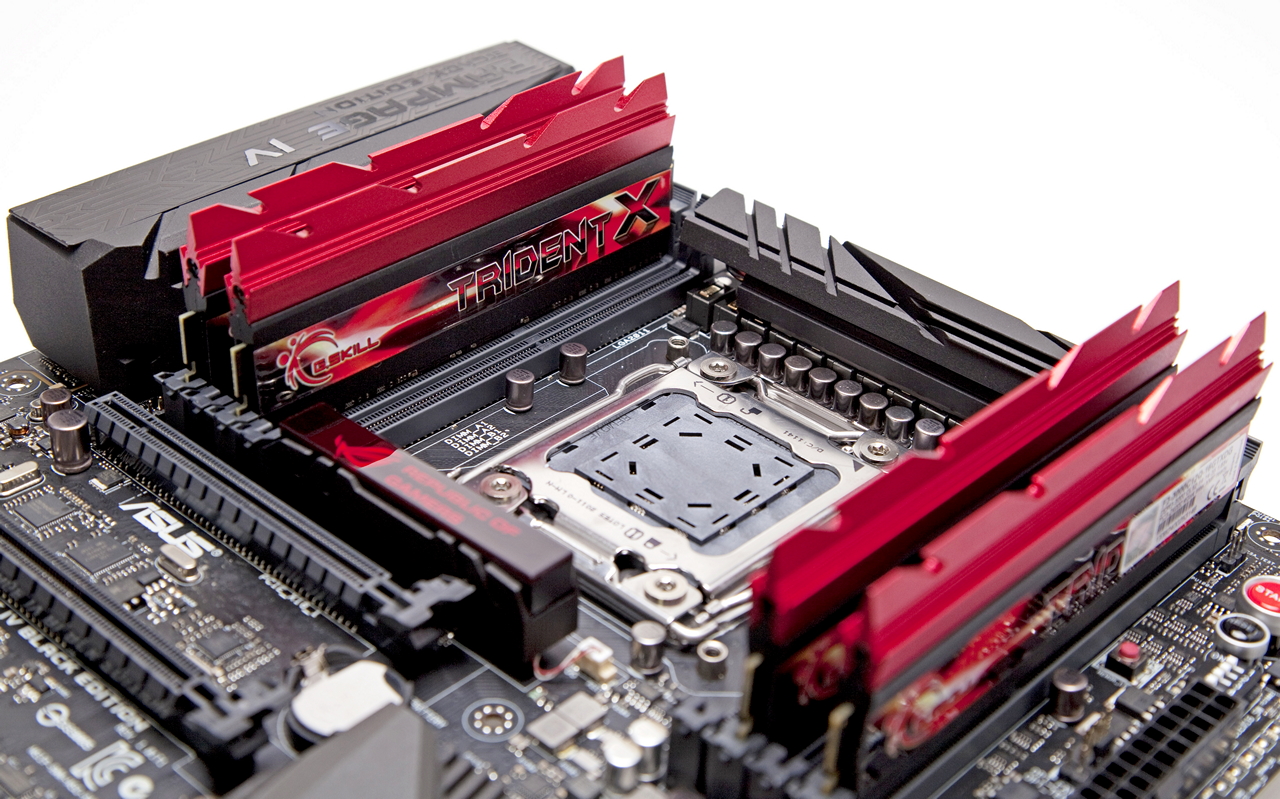G.SKILL Achieves Fastest Quad Channel Memory Speed
G.SKILL said on Wednesday that it has broken the world's record for the fastest quad channel DDR3. The company accomplished this feat by using a 16 GB (4 x 4 GB) G.SKILL TridentX memory kit, Intel's new i7-4960X "Haswell" CPU, the Asus Rampage IV Black Edition motherboard, and liquid nitrogen extreme cooling. This platform allowed the company to overclock the DDR3 memory kit to an insane 4072 MHz.
"No limit is too high for G.SKILL memory," the company said. "In just a week after the official release of the new Intel Ivy Bridge-E Core i7 Extreme processors, G.SKILL memory is already testing the extreme limits of the Intel processors and broke the world record for fastest DDR3 yet again."
The company also announced on Wednesday that it has teamed up with MSI, Lian Li and GX-Gaming USA in a "Global Gaming Giveaway" for simply showing support on all participating vendors' Facebook pages. The companies will give away huge bundles of hardware to the first and second place winners, as well as swag packs for third, fourth and fifth places consisting of an MSI Gaming Motherboard polo shirt and a G.SKILL lanyard.
To enter, hopeful winners must head here and "Like" the Facebook pages of G.SKILL, MSI, Lian Li and GX Gaming, enter their email address, and then share the contest link on their Facebook wall. The winners will be announced on October 31, 2013. Contestants can get a bonus entry each time a friend clicks this link and participates in the content.
Here are the contents of the two prize packs:
Ultimate Prize
MSI Z87-GD65 Gaming
MSI GeForce GTX 660 Gaming
G.SKILL SNIPER 32 GB DDR3 2133 MHz
Lian Li PC-A79
GX-Gaming Manticore
GX Gaming Gila
GX Gaming Cavimanus
Get Tom's Hardware's best news and in-depth reviews, straight to your inbox.
2nd Prize
MSI Z87-G43 Gaming
MSI GeForce GTX 650 Ti Boost Gaming
G.SKILL ARES 16 GB 1600 MHz
Lian Li PC-10N
GX Gaming Imperator
GX Gaming Maurus Black
GX Gaming Lychas

Kevin Parrish has over a decade of experience as a writer, editor, and product tester. His work focused on computer hardware, networking equipment, smartphones, tablets, gaming consoles, and other internet-connected devices. His work has appeared in Tom's Hardware, Tom's Guide, Maximum PC, Digital Trends, Android Authority, How-To Geek, Lifewire, and others.
-
opmopadop How come the link sais "RAM Speed : 2036 MHz (1:18) @ 14-31-15-45"Reply
Or do we double timings for the hell of it when the letters DDR are mentioned? -
WithoutWeakness Reply11604806 said:How come the link sais "RAM Speed : 2036 MHz (1:18) @ 14-31-15-45"
Or do we double timings for the hell of it when the letters DDR are mentioned?
"DDR" literally means "double data rate". The 2036 MHz in the screenshot is the memory controller's clock speed. Since DDR RAM transfers data twice per clock you calculate the speed of the memory by doubling the clock speed. Thus, the memory clock on the processor is running at 2036 MHz but the RAM itself is running at 4072 MHz. -
Pinhedd Reply11605267 said:11604806 said:How come the link sais "RAM Speed : 2036 MHz (1:18) @ 14-31-15-45"
Or do we double timings for the hell of it when the letters DDR are mentioned?
"DDR" literally means "double data rate". The 2036 MHz in the screenshot is the memory controller's clock speed. Since DDR RAM transfers data twice per clock you calculate the speed of the memory by doubling the clock speed. Thus, the memory clock on the processor is running at 2036 MHz but the RAM itself is running at 4072 MHz.
Close, but not quite.
The 2,036Mhz is the DRAM IO bus reference clock frequency. For a DDR system, data is transferred on both the rising and falling edge of the reference clock, for a data transfer rate of 4,072 MT/s (Mega Transfers per second).
The DRAM memory modules themselves run much slower than the IO bus. DDR SDRAM has a 1:1 ratio between the SDRAM core clock and the IO bus clock (two IO transfers are performed per core clock). DDR2 SDRAM has a 1:2 ratio between the SDRAM core clock and the IO bus clock (four IO transfers are performed per core clock). DDR3 SDRAM has a 1:4 ratio between the SDRAM core clock and the IO bus clock (eight IO transfers are performed per core clock). The rationale for this is that once an SDRAM row is opened, it is possible to concurrently read or write a large number of columns at once by using a buffer and then serialize them across the IO bus. DDR, DDR2, and DDR3 have doubled the depth of this buffer each generation from one, to two, to four, to eight words.
This relationship between IO transfer rate, IO bus reference clock, and SDRAM core clock gives rise to the rather flat real time latency values seen over the past couple of generations. The IO bus frequency has increased far faster than the memory modules themselves.
For example, DDR2-1066 has an IO transfer rate of 1,066MTs per pin, an IO reference clock of 533Mhz, and a core clock of 266Mhz (1:2 ratio).
DDR3-1066 has an IO transfer rate of 1,066MT/s per pin, an IO reference clock of 533Mhz, and a core clock of 133Mhz (1:4 ratio). -
khaledegy200 Omg! we still didn't get DDR4 yet and look what is out there http://www.dailytech.com/Micron+Samples+Hybrid+Memory+Cube+With+8x+the+Transfer+Rate+of+DDR4/article33446.htmReply -
opmopadop Reply11605610 said:The 2,036Mhz is the DRAM IO bus reference clock frequency. For a DDR system, data is transferred on both the rising and falling edge of the reference clock, for a data transfer rate of 4,072 MT/s (Mega Transfers per second).
Thank you. I was just trying to make the point that throwing 'Mhz' numbers around without explanation is confusing. Hence why I indicated that the linked page had one value and that this article doubled that value 'for the hell of it'.
